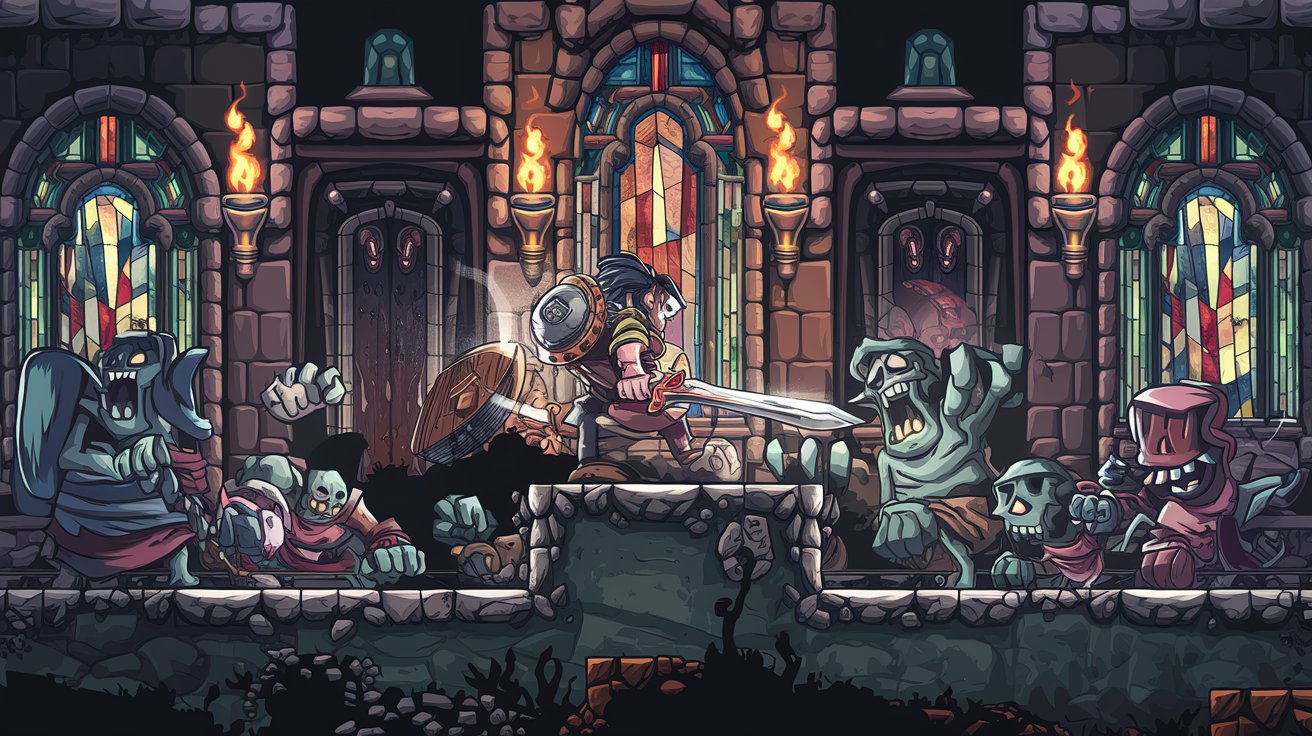Have you ever found yourself staring at a seemingly impassable barrier in a game, wondering if you missed something? Or perhaps you’ve backtracked through the same corridors multiple times, certain there must be a secret path you’ve overlooked? If so, you’ve experienced the quintessential Metroidvania conundrum — and you’re not alone.
Metroidvania games, a portmanteau of “Metroid” and “Castlevania,” represent one of gaming’s most beloved and enduring genres. These interconnected, exploration-focused adventures reward curiosity, persistence, and strategic thinking. But for newcomers — and even veterans facing particularly challenging titles — the genre’s complexity can sometimes feel overwhelming.
In this comprehensive guide, we’ll walk through everything you need to know to master Metroidvania games, from fundamental concepts to advanced techniques. By the end, you’ll have the knowledge to unlock every ability, discover every secret, and fully complete any Metroidvania that comes your way.
Understanding the Metroidvania DNA
What Makes a Game “Metroidvania”?
Before diving into gameplay strategies, let’s establish what defines a Metroidvania:
- Interconnected World: Unlike linear games, Metroidvanias feature large, interconnected maps where areas loop back on themselves in surprising ways.
- Ability-Gated Progression: You’ll frequently encounter obstacles that can only be overcome after acquiring specific abilities elsewhere.
- Backtracking: As you gain new powers, previously inaccessible areas become available, encouraging revisiting earlier locations.
- Non-Linear Exploration: While there’s usually a “correct” path forward, players often have multiple viable routes to explore.
- Progressive Power Scaling: Both character abilities and enemy difficulty evolve throughout the journey.
This formula has given us classics like Super Metroid, Castlevania: Symphony of the Night, and modern masterpieces such as Hollow Knight, Ori and the Blind Forest, and Dead Cells.
Getting Started: Essential Metroidvania Strategies

Embrace the Map
The map is your most valuable tool in any Metroidvania. Most modern entries in the genre include auto-mapping features, but you’ll still need to interpret this information effectively:
- Color-Coding: Pay attention to how different areas are color-coded. This often indicates difficulty levels or thematic zones.
- Incomplete Rooms: Partially explored rooms on the map frequently signal hidden passages or secrets.
- Map Markers: Many games allow custom markers. Use them liberally to tag areas to revisit when you acquire new abilities.
- Travel Points: Familiarize yourself with fast travel locations, elevators, and shortcuts to minimize backtracking time.
Understand Your Movement Options
Metroidvania games are as much about how you move as where you go. From the beginning:
- Master the basics: Jumping, dashing, wall-climbing — whatever your character can do initially, practice until it’s second nature.
- Experiment with combinations: Many games allow movement techniques to be chained together for extended mobility.
- Watch environmental cues: Specific background elements often hint at which movement technique is required.
Remember that each new movement ability you acquire doesn’t just open new paths — it transforms how you interact with all previously explored areas.
The Art of Ability Acquisition
Recognizing Ability Gates
The core progression loop in Metroidvanias involves recognizing, remembering, and returning to “ability gates” — obstacles that require specific powers to overcome. Common types include:
- Physical barriers: Walls too high to jump, gaps too wide to cross
- Environmental hazards: Extreme temperatures, toxic areas, or underwater sections
- Interactive elements: Special blocks, switches, or platforms that respond to specific abilities
- Enemy-based gates: Areas guarded by enemies vulnerable only to certain attack types
When you encounter an ability gate, take note of its distinctive visual or mechanical properties. This will help you recognize when you’ve acquired the tool needed to overcome it.
The Upgrade Hierarchy
While every game implements abilities differently, Metroidvania upgrades typically fall into these categories:
- Movement upgrades: Double jumps, dashes, wall climbs, grappling hooks
- Environmental protection: Heat resistance, water breathing, fall damage immunity
- Offensive capabilities: New weapons, attack types, or damage enhancements
- Utility tools: Map exploration aids, item detectors, enemy identifiers
Understanding this hierarchy helps prioritize which areas to explore next. If you’ve just acquired a movement upgrade, look for previously unreachable platforms before focusing on combat challenges.
Finding Every Upgrade: Methodical Exploration
To ensure you don’t miss any abilities:
- Explore edges first: When entering a new area, follow its boundaries before investigating the center.
- Look for anomalies: Unusually placed platforms, distinctively colored walls, or conspicuous empty spaces often hide secrets.
- Listen for audio cues: Many games use distinct sounds to indicate nearby hidden areas.
- Challenge assumptions: Just because a path seems to lead to a dead end doesn’t mean it actually does. Test walls for false sections and floors for breakable portions.
Advanced Techniques for Completionists
Sequence Breaking
“Sequence breaking” refers to obtaining items or accessing areas earlier than the designers intended through creative use of game mechanics. While not necessary for casual play, it’s a hallmark of Metroidvania mastery:
- Movement precision: Practice pixel-perfect jumps and timing to reach seemingly inaccessible ledges.
- Damage boosting: In some games, taking damage provides momentum that can be used to cross gaps.
- Physics exploitation: Look for ways to gain extra height or distance by combining movement abilities in unconventional ways.
Historical Note: Some of the most famous sequence breaks, like the “wall jump” in Super Metroid, have become so iconic that developers now deliberately include similar techniques in new games.
Speed Running Fundamentals
Even if you’re not aiming for record times, speed running techniques improve your overall efficiency:
- Route optimization: Plan paths that minimize backtracking and maximize upgrade acquisition.
- Boss strategies: Learn patterns to defeat major opponents quickly and safely.
- Movement chaining: Practice seamlessly transitioning between different movement abilities.
These skills are particularly valuable in games with time-sensitive achievements or endings.
100% Completion Strategies
For those determined to find absolutely everything:
- Systematic room clearing: Before leaving any room, ensure you’ve interacted with every element and checked every corner.
- Wall testing: Many secret areas are hidden behind breakable or illusory walls. If something looks suspicious, attack it or press against it.
- Ability cycling: Periodically cycle through all your abilities when exploring, as some secrets respond only to specific powers.
- Consumable tracking: Most games provide statistics on collected items. Use these to identify areas with missing pickups.
Game-Specific Approaches
While core principles remain consistent across the genre, each Metroidvania has unique mechanics worth understanding:
Metroid-Style Games
Games following the Metroid formula (including Axiom Verge, Environmental Station Alpha) typically emphasize:
- Weapon variety: Different enemies and barriers respond to different weapon types.
- Environmental storytelling: Narrative is often conveyed through visual cues rather than explicit text.
- Minimalist guidance: These games rarely provide explicit direction, instead using level design to subtly guide players.
Castlevania-Style Games
Titles in the Castlevania tradition (including Bloodstained: Ritual of the Night) generally feature:
- RPG elements: Character stats, equipment, and leveling systems add depth to progression.
- Enemy variety: Extensive bestiary with unique behaviors and vulnerabilities.
- Ability abundance: These games often include dozens of special moves and powers.
Modern Indie Interpretations
Contemporary entries like Hollow Knight and Dead Cells incorporate:
- Souls-like elements: More punishing difficulty curves and death mechanics.
- Roguelike components: Some include procedurally generated sections or permadeath variations.
- Movement mastery: Platforming challenges that require precise control and timing.
Adapt your approach based on which tradition your chosen game follows.
Common Pitfalls and How to Avoid Them
Getting Truly Stuck
If you find yourself unable to progress:
- Consult your map: Look for rooms with unexplored exits or incomplete exploration.
- Review your abilities: Consider how recent acquisitions might open new paths.
- Challenge assumptions: Areas that seemed impassable might yield to creative approaches.
- Take a break: Sometimes the solution becomes obvious after stepping away.
When to Use Guides: There’s no shame in consulting a walkthrough if you’re genuinely stuck. But try to look up only the specific obstacle giving you trouble rather than following a guide from start to finish.
Difficulty Spikes
Sudden increases in challenge usually indicate:
- You’re off the intended path: Consider exploring elsewhere and returning later.
- You’ve missed an upgrade: Search for overlooked abilities that might make the challenge more manageable.
- A skill check: Some obstacles are designed to ensure you’ve mastered certain mechanics.
Burnout Prevention
Metroidvania burnout is real, especially in larger games. To combat it:
- Set session goals: “Today I’ll explore the western zone” rather than “I must find the next major upgrade.”
- Alternate between activities: Switch between combat challenges, exploration, and collection.
- Celebrate small victories: Each new room discovered or secret found is an achievement.
The Joy of Discovery: Why Metroidvanias Endure
The true magic of Metroidvanias lies not just in completion, but in the journey itself. Each new ability doesn’t just open paths — it recontextualizes your understanding of the game world. Areas that once seemed impenetrable become navigable; enemies that were overwhelming become manageable.
This genre rewards curiosity, persistence, and ingenuity in uniquely satisfying ways. The “aha!” moment when you realize exactly how to use your new ability to access a tantalizing, previously unreachable area delivers a satisfaction few other gaming experiences can match.
Conclusion: Your Adventure Awaits
Armed with these strategies, you’re now prepared to tackle any Metroidvania adventure with confidence. Remember that these games are designed to be challenging — getting momentarily lost or stuck is part of the experience, not a failure.
Whether you’re diving into a classic like Symphony of the Night or exploring the latest indie sensation, approach each game with patience, curiosity, and systematic exploration. Map every corridor, test every wall, and experiment with every ability combination.
Your persistence will be rewarded not just with completion, but with the special satisfaction that comes from truly mastering one of gaming’s most beloved genres. The mysterious world and all its hidden powers await your discovery.
What’s your favorite Metroidvania game? Which ability upgrade gave you the most satisfying “a-ha!” moment? Share your experiences in the comments below!

Zareb Saleh is a journalist at Gulf Today and a ghostwriter for Gameoholic, specializing in gaming, technology, and digital culture. With a keen eye for industry trends, he delivers insightful stories that engage and inform readers.




